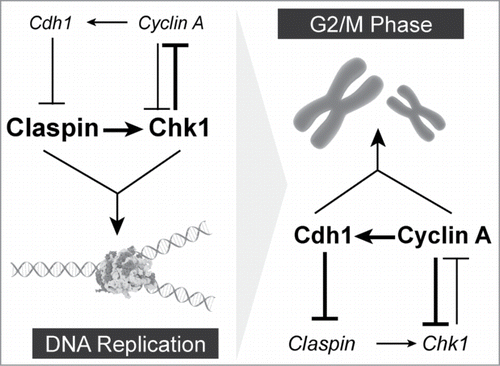Cell division is driven by the co-ordinated expression and destruction of cyclins, which bind to and activate cyclin dependent kinases (Cdks). Cyclin/Cdk activity drives the cell through the 2 active cell cycle phases of DNA replication (S phase) and cell division (Mitosis, M phase). In adult human somatic cells, these 2 active phases are separated by gap phases (G1 and G2), which provide the cell time to prepare for the next phase. Degradation of protein material is a key factor ensuring that cells only progress from G1 to S, G2 and then through M phase in the one direction. This dependence on degradation has been most extensively characterized during exit from mitosis, where degradation is directed by the Anaphase promoting complex (APC), a E3 ubiquitin ligase that in combination with its co-factors Cdc20 and then Cdh1 degrades key proteins, such as cyclin B and securin. This degradation ensures that that cells enter G1 and are unable to undergo a second mitosis. Degradation also plays a key role in regulating the transition between DNA replication (S phase) and mitosis.Citation1 Treatment of cells during G2 phase with proteasome inhibitors, such as MG132, blocks progression and arrests cells in G2,Citation2 indicating that there are key proteins that must be removed prior to entry into mitosis. Despite this critical function of protein degradation during the S/G2 transition, currently little is known about which proteins are degraded, and how degradation is linked with the cell cycle machinery during G2 phase. In this issue of Cell Cycle, some excellent work by Oakes et al provides an elegant model for how cyclin A/Cdk activity controls the degradation of Claspin, ensuring timely progression through G2 phase and entry into mitosis.Citation3
During an unperturbed cell cycle, progression through S phase is dependent on Chk1 and its binding protein Claspin, which are both involved in ensuring replication forks remains stable, progress correctly, and that origins of replication fire in the correct order.Citation4,5 Consequently, in preparation for mitosis, these proteins need to be ‘shut down’ upon successful completion of DNA replication during G2 phase. This is achieved primarily through the activity of cyclin A/Cdk1 and Plk1, with Cdk1 phosphorylating and inhibiting Chk1,Citation6 while Plk1 targets Claspin for degradation.Citation7 In this issue of Cell Cycle, Oakes et al provide additional information on how cyclin A also helps to regulated Claspin levels during normal G2 phase progression.Citation3 As levels of cyclin A, and its associated Cdk activity, increase during S/G2 phase, a corresponding increase in the level of the Cdh1 occurs. This increase in Cdh1 is dependent on cyclin A/Cdk activity, but independent of Plk1 activity, indicating that cyclin A is the central regulator of Cdh1 levels in G2 phase. This increase in Cdh1 levels in turn targets Claspin for degradation by the proteasome, which further decreases Chk1 activity, providing a positive feedback loop (). Failure to destroy Claspin either by depletion of cyclin A or Cdh1, results in cells delaying in G2 phase, highlighting the importance of removing Both Chk1 and Claspin during G2 for correct cell cycle progression. This process is analogous to cleaning up after the lunchtime (S phase) rush in a restaurant in preparation for the dinner menu (mitosis). Failure to remove the lunchtime items results in a backlog and everything grinds to a halt preventing the preparation of dinner. In summary, it highlights the importance that degradation plays in ensuring the fidelity of cell division is maintained and provides further evidence of how deregulation of the degradation machinery contributes to cancer and other genetic disorders.
Figure 1. Cyclin A regulation of Cdh1 during the S/G2 phase transition controls Clapsin and Chk1. During S phase, Claspin and Chk1 ensure DNA replication proceeds correctly. Once S phase is completed, they must be removed. This is achieved by rising cyclin A/Cdk activity, which increases the levels of the APC cofactor Cdh1 resulting in the degradation of Claspin. Loss of Claspin and direct phosphorylation of Chk1 by cyclin A help amplify this positive feedback loop.

Reference
- Eguren M, et al. Semin Cell Dev Biol 2011; 22:572–8; PMID:21439391; http://dx.doi.org/10.1016/j.semcdb.2011.03.010
- Burgess A, et al. Oncogene 2008; 27:5554–66; PMID:18504434; http://dx.doi.org/10.1038/onc.2008.167
- Oakes V, et al. Cell Cycle 2014; 13 (20); http://dx.doi.org/10.4161/15384101.2014.949111
- Scorah J, McGowan CH. Cell Cycle 2009; 8:1036–43; PMID:19270516; http://dx.doi.org/10.4161/cc.8.7.8040
- Ge XQ, Blow JJ. J Cell Biol 2010; 191:1285–97; PMID:21173116; http://dx.doi.org/10.1083/jcb.201007074
- Enomoto M, et al. J Biol Chem 2009; 284:34223–30; PMID:19837665; http://dx.doi.org/10.1074/jbc.C109.051540
- Mamely I, et al. Curr Biol 2006; 16:1950–5; PMID:16934469; http://dx.doi.org/10.1016/j.cub.2006.08.026
